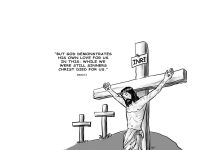BY ATTY. REX SALVILLA
MANY are not aware that the Panay Guerrilla was the best organized guerrilla movement during World War II.
This was because its commander, Col. Macario Peralta Jr. (Brigadier General after the war), patterned its table of organization after the regular US Army Infantry Division.
Even the famous guerrillas of Tito in Jugoslavia and Mao Tze Tung in China, being mass movements, were not so organized as a fighting unit.
The official name of the Panay Guerrilla was the “61st Infantry Division, Sixth Military District, Philippine Army.”
Aside from its combat units – the 63rd, 64th 65th and 66th Infantry Regiments – there was a host of combat support units which were non-combatants.
Here they were:
1. Signal Corps – under Capt. Amos Francia (after the war, he became a general); responsible for making the first guerrilla radio contact with Gen. Douglas McArthur in Australia among the guerrilla groups in the country
2. Corps of Engineers – responsible for secretly building an airport in Dumarao, Capiz where US planes airdropped arms and supplies for the guerrillas
3. Air Force Ground Unit – under Major Magin Bautista; responsible for management and security of the Dumarao airport
4. Transportation Section – re-activated the railroad line between Passi (Iloilo) and Dumarao (Capiz) with one locomotive with cars carrying arms and supplies from Dumarao airport to Passi to be distributed to the field units in Iloilo
5. Chemical Section – under Lieutenant Homer Villasis; in charge of looking for tubâ which they converted to alcohol for fuel of the locomotive engine
6. Ordnance Section – in charge of repairing guns, producing gunpowder and manufacturing grenades. For this purpose, they secretly utilized the foundry shops in Fundidor, Molo which produced grenades in bars (not round) to avoid Japanese detection.
7. Land Management Section – maintained the continued operations of abandoned farmlands and fishponds for food of the soldiers and campaigned among civilians for more food production
8. Currency Section – under Captain ariano Diolosa; in charge of printing guerrilla money for salaries of the soldiers and the civilian employees of the civil resistance movement under Gov. Tomas Confesor and secretly procuring paper and ink in Iloilo City
9. Finance Section – distributes emergency money to field units for salaries and clothing allowances of soldiers
10. Military Police – under Major Francisco Offemaria; in charge of maintaining discipline among the troops and detention of Japanese war prisoners
11. Judge Advocate Office – under Major Juan Borra (fter the war, he became a congressman and Commission on Elections chairman); in charge of court martial which had actually imposed penalties on erring soldiers like demotions, suspensions of salaries and imprisonment
12. Coastal Defense Section – in charge of observing movements of enemy ships in the seas, especially in the Antique area; securing the landing of US submarines bringing arms and supplies to the guerrillas; and establishing the first radar station in the country under Captain Ireneo Jamora
13. Intelligence Section (S-2) – under Major Salcedo; in charge of penetrating into enemy occupied areas for espionage missions and maintaining contacts with puppet provincial and municipal officials for co-existence purposes
14. Medical/Dental and Nurse Corps – in charge of treating the wounded and the sick, creating a mobile clinic and establishing a base hospital in Pototan, Iloilo; and also buying secretly medicines and supplies from drugstores in Iloilo City
15. Corps of Chaplains – composed of a division chaplain (Major Jose Tanalgo), and a regimental chaplain with assistants for every four regiments of the division; in charge of the spiritual and moral needs and formation of the soldiers. One of the regimental chaplains was Lieutenant Vicente Escutin who later became a brigadier general, and the other was Lieutenant Miguel Tadifa who became a colonel and chief of Philippine Army Chaplains.
16. Propaganda Corps – which had published the following guerrilla newspapers: Baloy Watchman of Lieutenant Juan Razo (after the war, he became a brigadier general), Flash of Lieutenant Rex D. Drilon (after the war, he became the first Filipino president of Central Philippine University) assisted by Lieutenant Jose Guevara (after the war, he became an Iloilo City Councilor), and the Liberator of Captain Jose Nava. The Civil Resistance Government under Gov. Tomas Confesor had Ang Tigbatas under Abe Gonzales.
17. Troop School – There were two troop schools organized to train soldiers for officership. The subjects were the regular one prescribed in the Officer’s School. Its final examinations were actual combats such as ambush or raid of the enemy detachments. The valedictorian of the first school was Vicente Acsay (later, a bar topnotcher) and the second one was Esmeraldo Eco (later, congressman of Camarines). Both were promoted to second lieutenants.
18. 63rd Infantry Regiment Band – under Sgt. Eliseo Gellor (retired PC Band member); organized by Major Epifanio Cabalfin with musician recruits from Alimodian, Leon and San Miguel, Iloilo. This 35-piece band furnished music for military field ceremonies as well as social functions of the soldiers. Its solo trumpeter was Jose Alquisada (later, conductor of the famous University of San Agustin Band).
19. Women’s Auxiliary Corps (WAC) – under Natividad K. Peralta, wife of Colonel Marcario Peralt, Jr. the head of Panay Guerrilla (officially, the 61st Infantry Division, Philippine Army).
Lastly, going to the combatants, some of them became generals like Ramon Gelvezon, Raymundo Teruel, Ceferino Carreon and Alfonso Palencia./PN







